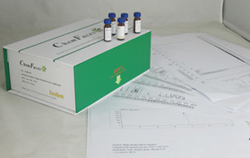Hot Products



| Catalog No. | Information |
| CFN98330 | Feretoside Feretoside can increase the expression of heat shock factor 1 (HSF1) by a factor of 1.153 at 3 uM. |
| CFN60150 | Ferrostatin-1 |
| CFN92178 | Ferruginol Ferruginol has anti-plasmodial, leishmanicidal, anti-ulcerogenic, cardioprotective, anticancer, anti-oxidative and anti-inflammatory activities, it can induce apoptosis in non-small cell lung cancer (NSCLC) cells. Ferruginol has antimicrobial and antifungal activities against wood-rot fungi (basidiomycetes), can cause cellular dysfunction and damage, lead to growth inhibition and autophagic cell death of fungi. |
| CFN99158 | Ferulic acid Ferulic acid is an antioxidant found naturally in plant cell walls , shows antioxidant activity in parallel with their radical scavenging activity, it has been approved in certain countries as food additive to prevent lipid peroxidation. Ferulic acid has been reported to have many physiological functions, including antioxidant, antimicrobial, anti-inflammatory, anti-thrombosis, anti- diabetic, and anti-cancer activities; it also protects against coronary disease, lowers cholesterol and increases sperm viability. |
| CFN99817 | Ficusin A Ficusin has antioxidant, antilipidemic and antidiabetic effects, it can lower the levels of fasting blood glucose, plasma insulin, body weight gain in HFD-STZ induced diabetic rats, and can significantly enhance the PPARγ expression and improve the translocation and activation of GLUT4 in the adipose tissue, suggests that ficusin improves the insulin sensitivity on adipose tissue and it can be used for the treatment of obesity related type 2 diabetes mellitusl. |
| CFN90005 | Fingolimod hydrochloride Fingolimod hydrochloride is an oral sphingosine-1-phosphate analogue that was approved by the FDA in 2010 for the treatment of relapsing forms of multiple sclerosis (MS). Fingolimod hydrochloride , a pak1 activator, can inhibit astemizole-induced hypertrophy and cytotoxicity in H9c2 cells, suggests that antihistamine-induced cardiac adverse effects are associated with pak1 expression and function.The gels containing 0.50% fingolimod hydrochloride (FNGL) and FNGL 0.50% plus 6% colloidal oatmeal have potential for the treatment of atopic dermatitis (AD). |
| CFN98176 | Fisetin Fisetin is an antimetastatic,antifungal, anti-inflammatory, antioxidant flavonoid, it has beneficial effect on periodontal disease, may via inhibiting MAPK activation and COX-2 expression without affecting cell viability. Fisetin can ameliorate photodamage by suppressing the mitogen-activated protein Kinase/Matrix metalloproteinase pathway and nuclear factor-κB pathways. Fisetin suppresses the accumulation of intracellular lipids by inhibiting GLUT4-mediated glucose uptake through inhibition of the mTOR-C/EBPα signaling in 3T3-L1 cells. |
| CFN70119 | Flavanone Reference standards. |
| CFN96893 | Flavoglaucin Flavoglaucin exhibits significant inhibitory effects on PTP1B, the IC50 value of 13.4, micrometer; it also shows good binding affinity for human opioid or cannabinoid receptors. Flavoglaucin appears to be an antitumor promoter, it also has anti-inflammatory effects, it shows inhibitory effects on inflammatory mediators via the induction of heme oxygenase-1 in lipopolysaccharide-stimulated RAW264.7 macrophages. Flavoglaucin exhibits a significant radical scavenging activity against 1,1-diphenyl-2-picrylhydrazyl (DPPH) with theIC(50) value of 11.3 microM. |
| CFN98446 | Flavokawain A Flavokawain A is an apoptotic inducer and immune- modulator ,it also shows anti-inflammatory, and anti-tumor activities.Flavokawain A can significantly reduce the expression of CDK1-inhibitory kinases, Myt1 and Wee1, and cause cyclin B1 protein accumulation leading to CDK1 activation in T24 cells.Flavokawain A may suppress LPS-induced expression of pro-inflammatory mediators via blockage of NF-κB-AP-1-JNK/p38 MAPK signaling pathways in the murine macrophages. |